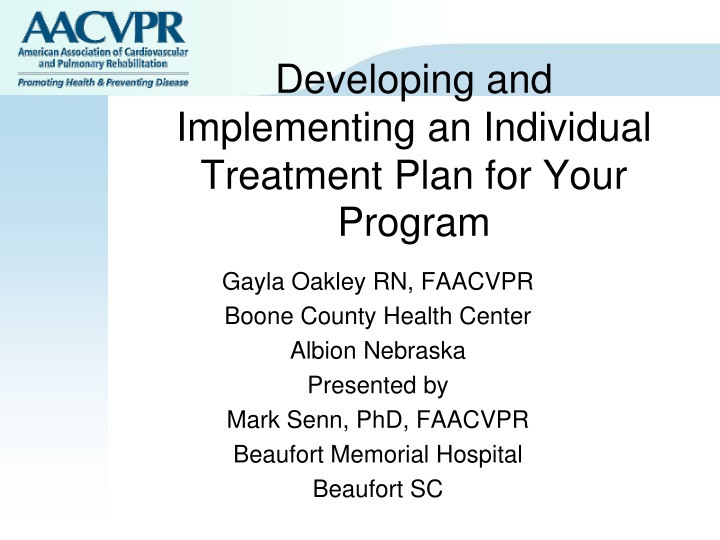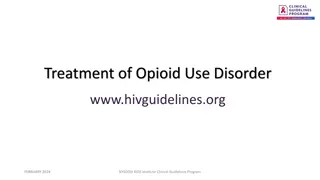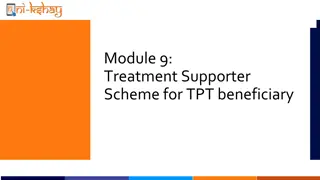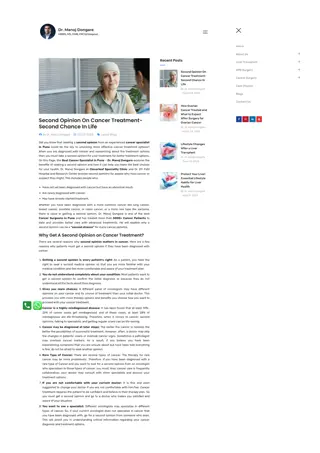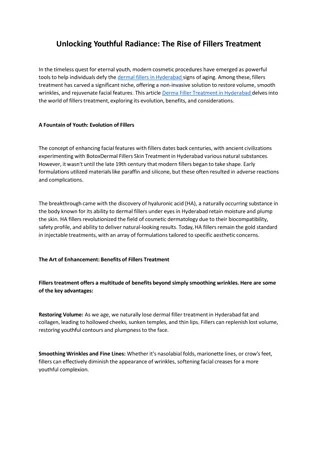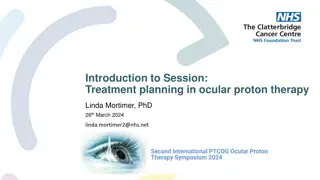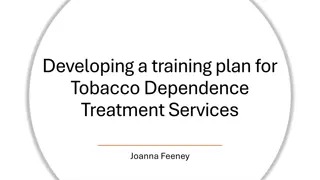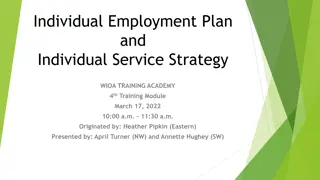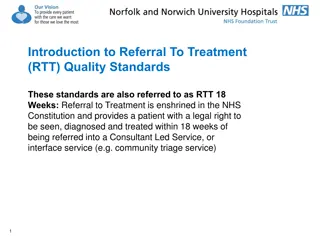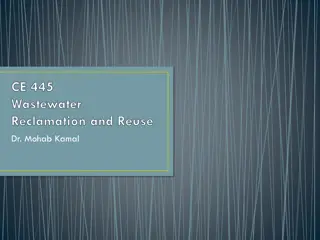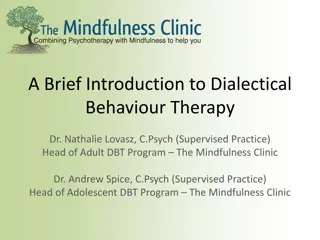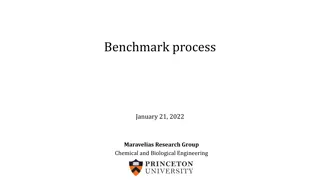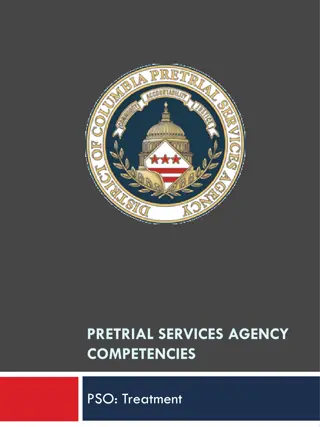Developing an Effective Individual Treatment Plan
A comprehensive guide on creating and implementing individualized treatment plans for patient care, covering assessment, intervention, reassessment, and discharge/follow-up. Learn about the importance of setting goals, intervention strategies, and meeting AACVPR requirements. Gain insights into assessing clinical factors, setting short-term and long-term goals, and determining action steps for successful outcomes.
Download Presentation

Please find below an Image/Link to download the presentation.
The content on the website is provided AS IS for your information and personal use only. It may not be sold, licensed, or shared on other websites without obtaining consent from the author.If you encounter any issues during the download, it is possible that the publisher has removed the file from their server.
You are allowed to download the files provided on this website for personal or commercial use, subject to the condition that they are used lawfully. All files are the property of their respective owners.
The content on the website is provided AS IS for your information and personal use only. It may not be sold, licensed, or shared on other websites without obtaining consent from the author.
E N D
Presentation Transcript
Developing and Implementing an Individual Treatment Plan for Your Program Gayla Oakley RN, FAACVPR Boone County Health Center Albion Nebraska Presented by Mark Senn, PhD, FAACVPR Beaufort Memorial Hospital Beaufort SC
What is an Individualize Treatment Plan? A road map of the best ways to provide care for our patients and takes them from the admission assessment through the discharge/follow-up. This map is to be utilized by ALL those responsible for the patient s management. An effective, comprehensive treatment plan can be the difference between a good and a great program.
AACVPR Requirements Comprehensive, single document Individualized Physician approved Each domain must reflect the rehabilitation process of Assessment Intervention Reassessment Follow-up/discharge Four domains Exercise, Nutrition, Education Psychosocial Clearly defined and clearly labeled.
Comprehensive components Assessment and Goals Intervention Reassessment Discharge/Follow-up
Assessment Intervention Discharge Follow up Re-Assessment
Assessment Starting point Gather information clinical factors/behaviors to change Need all the data before you can make the plan What is the goal? (ACC/AHA Guidelines for Secondary Prevention) Need an assessment for exercise, education, nutrition and psychosocial Example: (exercise) 6-MWT or DAISY or GXT
Goals Goals: What is to be accomplish and what is the timeline. Short Term Goals Patient goals. They have the right to know, understand and make informed choices but it is the facilitator job to help guide and make the plan. Must be measurable and attainable. Write goals as if will have patients two weeks. Constantly reassess. Long Term Goals Assess Beyond rehab
Intervention Action steps necessary to accomplish goals Evidence based (NCEP, ACC/AHA, ADA, JNC7, ACSM) Reasonable expectations Specific, measurable and relevant Individualize, keep in mind contraindications, individual abilities, limitations Example: (exercise) progressive exercise program in rehab and at home
Re-Assessment Evaluation of effectiveness Obstacles How did it work May have to revise plan May lead to further assessment Measurable Example: (exercise) repeat the 6-MWT
Follow-up/Discharge Was everything accomplished Where to go from here? Keeping on track, what else might be helpful How is the ITP reviewed or revised Pose the next clinical question Constantly evolving Example: the goal to be able to walk 30 minutes without stopping was not met ..now what?
Foundation pieces Exercise Nutrition Psychosocial Education
Additional pieces Disease management/secondary prevention model. Need for improving the chronic disease risk status of its clients, foster healthy behaviors and compliance with these . Coordinate the multidisciplinary care necessary to achieve the Evidence- based outcomes that result in decreased morbidity and mortality and overall cardiovascular risk reduction.
CMS Regulatory Requirements 410.49 Individualized treatment planmeans: A written plan established, tailored to each individual patient. Established, reviewed, and signed by a physician and signed every 30 days that includes; (i) The individual s diagnosis. (ii) The type, amount, frequency, and duration of the items and services under the plan. (iii) The goals set for the individual under the plan. .
Statutory Requirements Related to ITP (cont) Psychosocial Assessment A written evaluation provided by CR staff to assess an individual s mental and emotional functioning related to theindividual s rehabilitation or respiratory condition. Pulmonary add; as exercise conditioning, breathing retraining, step and strengthening exercises. An assessment of those aspects of an individual s family and home situation that affects the individual s rehabilitation treatment. A psychosocial evaluation of the individual s response to and rate of progress under the treatment plan. Physician supervised Physician prescribed exercise, including aerobic exercise, prescribed and supervised by a physician that improves or maintains an individual s functional level. (Cardiac) risk factor modification, including education, counseling, and behavioral intervention; related to the individual s care and tailored to the individual s needs
Statutory Requirements Related to ITP (cont) Education or training. Education or training closely and clearly related to the individual s care and treatment which is tailored to the individual s needs. (Pulmonary) Education includes information on respiratory problem management and, if appropriate, brief smoking cessation counseling. Any education or training prescribed must assist in achievement of individual goals towards independence in activities of daily living, adaptation to limitations and improved quality of life.
AACVPR ITP Template Different concepts, some struggle Doing a good job but unable to put into a comprehensive plan ITP comprehensive so that anyone can run the patient care plan Template A suggestion/example
AACVPR Requirements Comprehensive, single document Individualized Physician appproved Four domains Exercise, Nutrition, Education Psychosocial Each domain must reflect the rehabilitation process of Assessment Intervention Reassessment Follow-up/discharge Clearly defined and clearly labeled.
AACVPR ITP Template Modifiable Adapt to work in your program.
Evaluation Psychosocial Intervention Psychosocial Assessment Psychosocial Follow-up Psychosocial Intervention Nutrition Follow-up Nutrition Evaluation Nutrition Assessment Education Assessment Nutrition Evaluation Nutrition Evaluation Education Assessment Education Follow-up Education Intervention Education
Does your Individual Treatment Plan???? Does your ITP tell a complete story? Are you focusing on the data that will be most beneficial to your patients? Are you managing the chronic disease risk of your patients? Does it allow ALL of the care team to know exactly what has been completed and what still needs to be done?
AACVPR ITP Template Member-only benefit Cardiac or pulmonary
Statutory Requirements Related to ITP PL 10-275, effective date 1-1-2010 Outcomes Assessment Evaluation of progress as it relates to the individual s rehabilitation which includes the following: Beginning and end evaluations, based on patient- centered outcomes, which must be measured by the physician immediately at the start and end of the program. (Cardiac) Objective clinical measures of exercise performance and self-reported measures of exertion and behavior. Programs have the flexibility to determine what measures and tools are used. (Pulmonary) Objective clinical measures of effectiveness of the PR program for the individual patient, including exercise performance and self- reported measures of shortness of breath and behavior.
